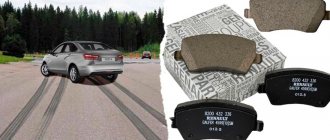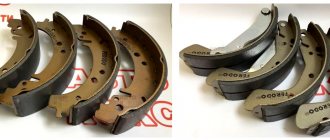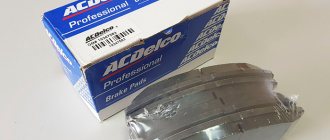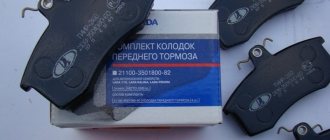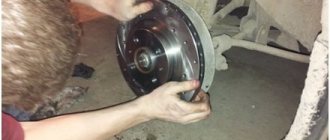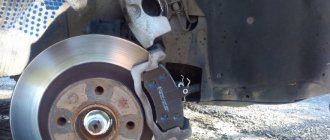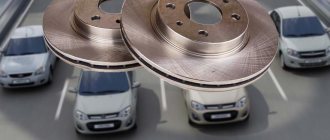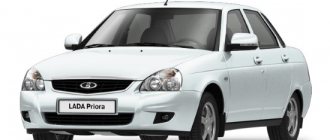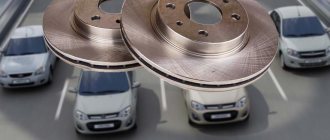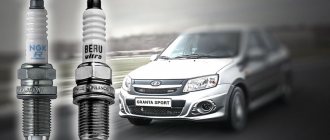Many cars have brake systems on both the front and rear wheels. Permanent replacement is performed on the front wheels. Depending on the quality of the brake pads, the braking efficiency is determined. To understand which pads are best to put on the vest, you need to read a lot of information and listen to the opinions of professionals.
The brake pad itself has a metal base in the form of a plate and special linings; wear resistance, rigidity and speed of the braking process depend on all elements in the complex. Drivers claim that the higher these components, the more effective the braking.
What types of brake pads are there?
In total, the following types of brake pads are distinguished:
- Polymetallic (they consist of 35 to 65% metal, have a long service life and have high thermal conductivity. However, they can make noise, damage the rotor and react with reduced performance at sub-zero temperatures).
- Organic (they are made from a fibrous base such as rubber, glass or carbon. When used, these elements are quiet because they have a soft base, but they wear out faster and become covered with dust faster).
- Low-metal (made from an organic medium with the addition of steel or copper, which improves heat transfer and braking speed. Their disadvantage is that if the base contains a large amount of metal, the brake pads make a lot of noise and quickly gather dust).
- Ceramic (the highest quality brake pads, which are made of ceramics. They are very quiet, do not get dusty and are very expensive).
Basic faults
If we exclude the possible defective parts and poor quality from the manufacturer, then the main reason why the front pads on the Lada Vesta become unusable is wear. They actively interact with other parts of the brake mechanism, and therefore a look at the nature of damage to the friction linings will make it clear what is wrong with the operation of the brake system. By correcting this error, you will increase the service life of not only the pads, but also the entire mechanism.
The nature of the malfunctions can be noted:
- Uniform wear - it manifests itself in the fact that the friction layer is worn evenly, this shows that the brakes are working well.
- Severe wear of the friction layer, brake rivets are visible - this means that you have been using the “outdated” parts for too long. The rivets could damage the disc, so it would be a good idea to inspect it for damage.
- The friction layer is worn evenly around the entire circle, but one of the sides is worn out more than the other - one of the parts of the brake system (guide or piston) does not distribute the braking force correctly. Cleaning all “live” parts and applying a new layer of lubricant will help. Naturally, everything will have to change.
- Both components are worn unevenly, the surface is strewn with irregularities and roughness. The reason for this outcome is a malfunction of the caliper guide pins - they swing and do not give an even trajectory of movement. You will have to clean them, then reapply lubricant.
- The friction lining is cracked - in this case, the “trouble” is caused by the brake discs themselves - they wear unevenly. Everything will have to change.
- Uneven wear of the friction layer means that the parts were installed incorrectly. They will have to be changed.
After performing a visual inspection of the damage, you can independently make a verdict about the breakdown. And besides this, there are several other signs by which you can find out about a faulty front pad while sitting behind the wheel.
Creak
If a squeaking noise occurs from the front when braking, this means that the pad and disc are not mating. This happens when a cheap analogue was purchased to replace the original component. But not everything is so bad - sometimes this analogue can last a long time, but the real reason is dirt that has gotten into the moving parts and reduces the contact area of the moving parts.
Vibration at speed: what is it?
Vibration at speed appears when the pads do not fit the discs - there is some incompatibility that does not manifest itself in the operation of the “original” parts. If, when braking, you still get “full contact” of these parts of the brake mechanism, this means that the wear of the hub discs themselves is haunting, and they will have to be replaced.
In what case should you change the pads on the Lada Vesta?
Professionals and amateurs advise resorting to replacing pads when:
- The brake pads have reached their service life.
- The surface of the brake pads was worn evenly or unevenly.
- The friction material of the pads has a thickness of 1 mm.
- A manufacturing defect has been detected.
- The car does not brake well.
- A loud grinding noise is heard when braking.
- When you press the brake pedal, it vibrates more.
- When, during braking, the car begins to roll along the road in different directions.
- The handbrake does not work.
- A sharp decrease in the brake fluid reservoir.
- When a dark coating appears on the wheel, it means that the friction lining is still intact, but the metal has been worn away.
- The brake pad sensor indicator lights up on the panel when there is a fault.
Rear brake pads Lada Vesta - replacement
The moment to replace and repair the rear pads on a car is determined by the fact that they are in a state of maximum permissible wear. You should also start planning a replacement if the linings are oily, or if chips, cracks and damage are visible on them, as well as a gap between the base of the consumable and the lining.
It is important to understand that the consumables on the rear wheels need to be changed as a set - so that the force is uniform, otherwise the car may skid when braking, and the braking itself will be ineffective. You need to install all four parts.
How to choose front brake pads for Vesta?
On the advice of experts, you should resort to the following recommendations when choosing brake pads:
- The product must be suitable for the appropriate car brand and have installation instructions.
- The friction surface must be uniform without any changes on it.
- There should be no cracks on the friction surface or on the metal surface.
- All elements must be in close contact with each other.
- Decide on your driving style. If you drive aggressively, then you need metal brake pads. They will work effectively when needed, but if you like a quiet ride, then ceramic brake pads are for you.
Original or non-original?
All pads can be divided into two categories:
- original;
- analogues.
The advantages of original brake pads are obvious, but they cost twice as much as their analogues. They are sold in original packaging made by a trusted manufacturer.
High-quality analogues are only slightly inferior in their characteristics to original spare parts. These pads are cheaper while still providing adequate braking performance. However, there are analogs made from low-quality materials. Typically, such gaskets are not properly tested and do not meet generally accepted standards.
When choosing spare parts, it is important to avoid mistakes: too low a price should alert you. You need to use proven auto parts, and when we are asked which brake pads are best for the West, we recommend using original spare parts.
How to distinguish an original part from a fake:
- Please note that the certification mark is present. If you don't see R90 or 90R on the label, it's a fake.
- The package must contain a product passport, warranty certificate, quality certificate and installation manual.
- The surface of the original brake pads must be smooth and uniform.
- Check the unique part number on the manufacturer's website.
Replacing front brake discs
The replacement algorithm includes the main steps:
- it is necessary to remove the wheel and jack up the car;
- the old brake pads are removed - to do this, the guide bolts are unscrewed and the caliper is folded back;
- The bracket is carefully hung on the suspension, after which you can begin to remove the disk - two nuts are unscrewed;
- if for some reason the disk cannot be removed from the bolts, you need to lightly hit it with a hammer from the reverse side;
- The new disk is carefully installed.
The nuts are screwed into place. It is advisable to pre-lubricate the threads with graphite lubricant. This will prevent souring. It is advisable to change the pads along with the discs.
Causes and signs of worn pads
Which brake pads to choose for your car and not go wrong
? You can determine the need for replacement or preventive inspection of the pads by a number of characteristic signs. Malfunctions consist either in low-quality components, causing destruction of the friction material, or in natural wear.
Increased parking brake travel
Since the Lada Vesta is equipped with rear drum brakes, this feature is relevant for it. Normally, the handbrake is raised 3 or 4 clicks. A sign of wear is a rise of 5-7 clicks. When stopping on a hill, the car rolls with the handbrake raised - the handbrake does not hold. The problem may be a stretched cable, but it wouldn't hurt to check the pads.
The wear sensor gives a signal
Vesta is equipped with a brake pad wear sensor in the maximum configuration. When the friction material lining thins to a critical level, the sensor will begin to make a characteristic sound with each braking. On some cars, an electronic type sensor is installed; it signals wear and tear with a warning light on the instrument panel.
Brake fluid level decreases
If the main element of the brake system is in a worn condition, then in order to effectively press it against the disc or caliper drum, the cylinders must exert more force, using more fluid. Accordingly, a decrease in its level can be observed. The volume of brake fluid may decrease if the cylinders are faulty, hoses or lines are damaged.
Long travel brake pedal
As in the previous case, if the pads are worn out enough, then greater effort is required to press them, and accordingly, the pedal stroke increases.
Damage to pads
On disc brakes, mechanical damage (flaking, chips, cracks) can be seen with the naked eye. They can also be found on the disks themselves.
Unevenly worn pads
If increased wear of the friction material is observed on one side relative to the other, this may indicate a failure (jamming) of one of the calipers. If you do not change it, then replacing a set of pads will do nothing - the wear will be just as uneven, and braking will be ineffective and even dangerous, since the car will pull to the side.
Increased braking distance
It is urgent to replace spare parts of the brake system if the car’s braking distance has become unnaturally long. Low braking efficiency may indicate severe wear of the front pads - they wear out much faster than the rear ones, as they take a greater load. Another reason could be a faulty caliper, a leaking system, or low brake fluid levels.
You can determine the degree of wear yourself; it takes no more than an hour. All you need to do is remove the wheels and inspect the friction material. In the case of drums, you need to remove them first. At the same time, you can assess the condition of the drums and discs for wear, cracks and other mechanical damage.
In the most advanced cases, the indicator of critical pad wear will be a grinding noise when braking. This occurs when the lining wears down to the base and the metal plates of the pads begin to rub against the discs or drums. Operating a vehicle with such wear is prohibited, as it can lead to jamming of the drums and serious damage to the discs, which ultimately will require them to be completely replaced.
What rear brake discs can be installed on the Lada Granta
Despite the fact that this car belongs to the budget class and is one of the cheapest among those sold in the Russian Federation, it is equipped with rear disc brakes. Which implies the need to replace individual components. The price of parts depends on their type, as well as other factors.
It is important to remember: the front and rear discs differ in the diameter of the mounting holes and other parameters. Installation can be done by yourself. The process itself is simple. But it requires some preparation. It is important to decide on a budget for parts in advance. All of them are divided into two main categories - analogues and originals. They differ in price and quality.
There are many types of discs. These are ventilated, with notches and various others. If the driver practices an aggressive driving style, then you should opt for ventilated models. They cool faster. They have more resources. The replacement process is no different from the others.
Original
Buying original parts is a good solution if you have an unlimited budget. AvtoVAZ products are quite expensive. Especially when compared with analogues from China. Original TD:
NameArticle Cost, rubles
| AvtoVAZ brake disc (can be marked as Renault) | 432007595R | 9 thousand rubles per pair |
Analogs
The cost of original components is an order of magnitude higher than analogues. Therefore, the choice of many vehicle owners falls on substitutes. The most advantageous offers:
NameArticle Cost, rubles
| A.S.P. | 2702220 | 2 thousand rubles. for 1 piece |
| B.M. | BDV 885 | 1 thousand rubles for 1 piece. |
| Hella | 8DD355109331 | 1.6 thousand rubles for 1 piece. |
Vesta and Grant drums and differences in design
It’s impossible to look at what rear brakes are installed on the Lada Vesta now without being surprised. We remove the wheel and see: there are no fastening elements on the body.
Rear drum, serial Lada Vesta
In fact, one element will be hidden under the hood. Break off the cap and everything will become clear.
You will need a 30mm spanner, but don’t rush! First of all, to remove the drum, you need to do the following:
- Release the handbrake;
- Use a thin screwdriver to rotate the ratchet upward to bring the pads together.
The required hole is one of four
The ratchet in the brake drum regulates the adjustment of the unit as a whole. But there is no need to remember how many revolutions were made. On the contrary, before installation, the adjustment is set to a minimum.
If even rear disc brakes were installed on the Lada Vesta, everything would be simpler than with a “new drum design”. The drums on the Lada Grant are different.
Granta and its rear brakes
Previously, two studs were unscrewed, and that was enough. The ABS sensor was also easy to remove: disconnect the connector and unscrew the screw. On Vesta this option is not provided.
It was decided before the design stage whether to install drum or disc rear brakes on the Lada Vesta. Too many changes have appeared in the design of drums - and they can only be made through painstaking work. This means that the engineers received the “order” in advance.
What can you see inside the drum?
We will not argue with which rear brakes were chosen for installation on the Lada Vesta. The reliability of the drums can be considered good, and with the transition to the new generation it has increased. You can see this for yourself.
One view of the brake cylinder now inspires respect: the body is covered with ribs and made using casting technology. The design uses a spacer bar, however, only original pads are compatible with it. Therefore, pads from Grants (for example, 2108-3502090) are absolutely not suitable.
A spacer bar is connected to the pads
The bar is compressed if you turn the ratchet upward. And vice versa.
The spacer bar assembly itself is a complex mechanical system. It automatically adjusts the gap between the drum and the pads. But the main thing is that this system also keeps the handbrake mechanism in working order! You can now forget about setting the parking brake.
A few words about the sensor
The ABS sensor appeared on Grants, as well as on the second Kalinas. But it is simply attached there.
Sensor connector and mounting screw
Knowing what rear brakes are currently installed on Lada Vesta, we warn you: do not look for a similar connector on the back of the drum. It is located very inconveniently. It is easier to dismantle without removing or unscrewing anything. The main thing is not to damage the sensor housing (see photo).
ABS sensor plastic housing
The tachometer disk disappeared from the Vesta drum design. And this is great luck! The disc itself was easily damaged when replacing pads.
Above we talked about the speed sensor. Its number in the VAZ catalog is: 8450006893 (right side), 8450006894 (left).
Replacing rear pads
To replace the rear pads with your own hands, without resorting to the help of specialists, you will need about two hours of free time and a minimum set of tools: a hammer, a screwdriver, pliers and a 36 mm socket. All actions are performed in the following order:
- using a jack, the rear part of the car is raised - the wheel bolts are first loosened, and a stop is placed under the front wheel - and the wheel is removed;
- if the car is in a stable position, the handbrake goes down to its extreme position - you will need to loosen the handbrake cable;
- Using a screwdriver and a hammer, you need to remove the cap covering the hub nut;
- use a 36 mm wrench or socket to unscrew the hub nut;
- the brake drum is removed;
- Using a screwdriver, remove the handbrake cable from the shoe lever;
- springs are disconnected;
- use pliers to remove the spring clip;
- the support is removed from the opposite part in the same way;
- the spacer bar and the block in front are removed;
- the rear block is removed;
- the tip of the parking brake cable, which is attached to the lever from the rear side, is disconnected;
- By disengaging the adjustment mechanism is removed.
Before reassembling the unit in the reverse order, it is necessary to thoroughly clean all parts from dust and rust and lubricate the drum with a special lubricant.
Replacing brake discs
You can replace the brake discs yourself. The main thing is the availability of a place for work, as well as the necessary materials and tools. When performing the corresponding manipulations, you should remember that the procedure for replacing the front and rear parts of a car has some differences.
Required materials and tools
To replace brake discs, you will need the following materials and tools:
- the spare parts themselves;
- jack;
- wrenches designed for nuts 7, 13 and 17 mm, as well as a wheel wrench;
- torx head t12 for unscrewing and dismantling the caliper;
- lubricant;
- extension;
- ratchet;
- hammer.
Replacing front brake discs
To replace the front elements, proceed as follows:
- Remove the wheel and raise the vehicle using a jack.
- Remove the guide fasteners and swing out the brake pad to remove the old pads.
- Place the bracket on the pendant.
- Unscrew the disk fasteners, lubricate them to facilitate dismantling, and then remove the elements - if the elements cannot be removed, carefully hit them with a hammer from the back side.
- Install new parts and tighten fasteners.
Attention! When performing the disc replacement procedure, it is also recommended to install new pads.
Replacing rear brake discs
To change the rear elements, follow these instructions:
- remove the wheel and lift the vehicle using a jack;
- remove the caliper, pads and disc;
- install new spare parts - first install the disc, then assemble the caliper and secure the pads.
What front brake discs should be installed on the Lada Granta
The front wheels of the Lada Granta are equipped with disc shoe brakes. What makes the pedal informative is that it makes it easy to calculate where to stop.
The power reserve with original parts can range from 50 to 120 thousand km. But sooner or later the need for replacement arises.
You can divide all supplied spare parts into two main categories: original and analogues. The former are more expensive. But at the same time, their maximum mileage is usually an order of magnitude greater than their analogues. There is multi-stage quality control in production. The downside is the high cost. Sometimes it is 2-3 times more than analogues.
The latter are distinguished by their availability. But not all parts are reliable. It is best to give preference to well-known brands that have proven themselves on the positive side.
Original
The advantage is exact compliance with the specified dimensions. After purchasing the part, there is no need to adjust it to size or grind it down:
Main differences between disc and drum
The braking mechanism consists of several parts and differs in two types of design.
The disk unit has an open design, allowing the device to operate for a long time without overheating. When you press the brake pedal, the brake pads are pressed against the disc mounted inside the wheel rim using a caliper. The degree of compression of the disc by the calipers is very high, which allows the car to brake more efficiently. As a result of heavy loads, the mechanism has a relatively short resource.
The drum mechanism has a closed cylindrical body, which prevents the entry of dirt and dust and has a long working life. The brake pads are pressed against the inner surface of the drum, causing the car to stop. The pressing force of the elements is comparatively lower than that of analogues with a disk, therefore such mechanisms are considered less effective.
The combination of front discs and rear drums is optimal in terms of efficiency and durability. This version of the Lada Vesta justifies itself with its reasonable price and reliability.
Top 3. Renault 410608481R
Rating (2020): 3.97
- Nomination
The best combination of price and quality
Optimal performance characteristics and a fair price show the best ratio among these products for Lada Vesta.
- Characteristics Average price: 1510 rub.
- Country: France
- Thickness, mm: 17.3
- Wear warning indicator: yes
Front brake pads under article number 410608481R can be installed on a number of RENAULT and Lada models, for example, on Largus or Lada Vesta. The original spare part (the factory puts them on the assembly line) is distinguished by its quality and perfect fit. In practice, the pads prove to be wear-resistant and quiet. They brake excellently and work out their service life in full. Due to the average rigidity of the friction material and fine abrasiveness, the discs do not wear out. If you decide to replace the pads on your Lada Vesta or Renault Duster, this is the best option, according to buyers. The range of prices on the market indicates the presence of counterfeit products. The retail price of the kit is significantly less than 1,500 rubles and should be alarming.
Advantages and disadvantages
- European quality
- High braking efficiency
- No squeak
- Good work resource
Wide range of prices on the market
The best front brake discs
Here are the best front brake discs.
Alnas Sport 2112-3501070-01
These are high-quality cast iron discs that have a long service life. Spare parts provide smooth braking without vibrations. The elements quickly “grind in” to the system and fit like a glove.
The model is characterized by a long warranty period. However, it only applies when parts are installed at a service center, for which there must be appropriate documents.
Alnas Sport 2112-3501070-01
Characteristics:
- material – cast iron;
- minimum thickness – 18;
- number of holes for fasteners – 4;
- centering diameter – 58.5 mm;
- weight – 12 kg.
pros
- excellent quality;
- increased strength;
- long operational period;
- smooth braking without vibration;
- acceptable cost.
Minuses
- If you install it yourself, the manufacturer's warranty will no longer apply.
ATE PowerDisc
These are high-quality German-made brake discs made of high-carbon cast iron. The products are characterized by increased strength, resistance to low temperatures and temperature changes. The elements provide smooth and effective braking without runout. The model is characterized by a long operational period and reasonable cost. The products have reliable protection against the accumulation of gas cushions between these parts and the pads. Therefore, the braking system will not lose its effectiveness due to this.
